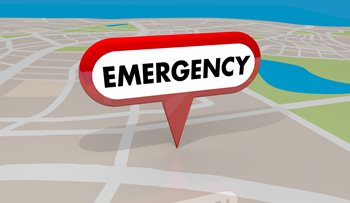(6/7/2021)
Emergency management departments are crucial to the safety of any facility, as they are responsible for preparing for unpredictable situations like natural disasters, power outages, medical catastrophes - or even all three at the same time. Although emergency management (EM) teams can handle a lot, this past year has presented many unique challenges in the face of the COVID-19 pandemic. EM teams everywhere are now using these experiences to formulate new solutions and plan for the future.
 Communicating emergency situations effectively.
Communicating emergency situations effectively.
Healthcare facilities can have the most comprehensive emergency management plans, but without effective communication practices in place those plans often aren’t able to be executed successfully. Streamlining communication processes and having the infrastructure in place to quickly share news with patients, family, staff, supportive agencies and more is key to successfully navigating any emergency situation.
One valuable lesson organizations have learned from COVID-19 is the importance of having one primary department lead the communication of key information. At Medxcel, pointing to the
CDC as a singular reliable source prevents misinformation from spreading widely to the public.
Integrating EM teams into daily operations.
Emergency management must be fully integrated with operations in order to be efficient, rather than simply being another line item in an organization’s budget. The EM team must be a known entity and point of contact within the hospital. If emergency management is only taken into account when there is a disaster, staff may not know the correct person to contact to handle the situation. Staff must view the emergency management experts as trusted resources, otherwise they may rely on Emergency Room staff or others that deal with high-pressure situations to manage circumstances that are outside of their area of expertise, leading to confusion and missteps within the organization.
Failing to prepare for every emergency can be a costly mistake and having plans in place can actually generate revenue by allowing facilities to stay open during times of disaster and provide care to patients.
Improving future emergency management planning.
Moving forward, healthcare leaders are searching for more ways emergency management can be involved in day-to-day operations. The testing element of crisis response plans became a priority during the pandemic, as teams were often executing plans that they had spent years putting together for the first time. Many new things had to be accounted for, such as the massive surges in patients and the lasting impact it had on staff and access to necessary supplies. Medxcel was able to standardize emergency management plans across our 161 hospitals and 2,600 sites of care during this time, resulting in a united effort to prevent the spread of COVID-19.
Creating a high-quality program that is consistently being assessed for ways to improve allows facilities to better prepare for future emergencies. Improving the future of emergency management doesn’t need to be costly, but rather teams must work together to further integrate practices and sustain organizations to endure hurricanes, tornadoes or even the next pandemic.
To learn more, listen to
episode three of our new podcast Outside the Patient’s Door at
outsidethepatientsdoor.com, or find us on Apple Podcasts, Spotify, Google Podcasts and more. Guests Chief Nursing Officer at CipherHealth Lisa Romano, and our own Vice President Emergency Management Scott Cormier, explore how emergency management departments make extraordinary situations seem like everyday challenges.
Interested in learning more about Medxcel’s services? Contact us at
info@medxcel.com or 855-633-9235 to see what we can do for you!